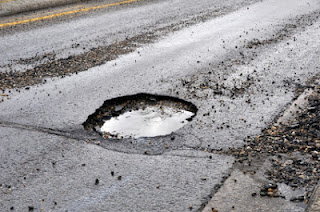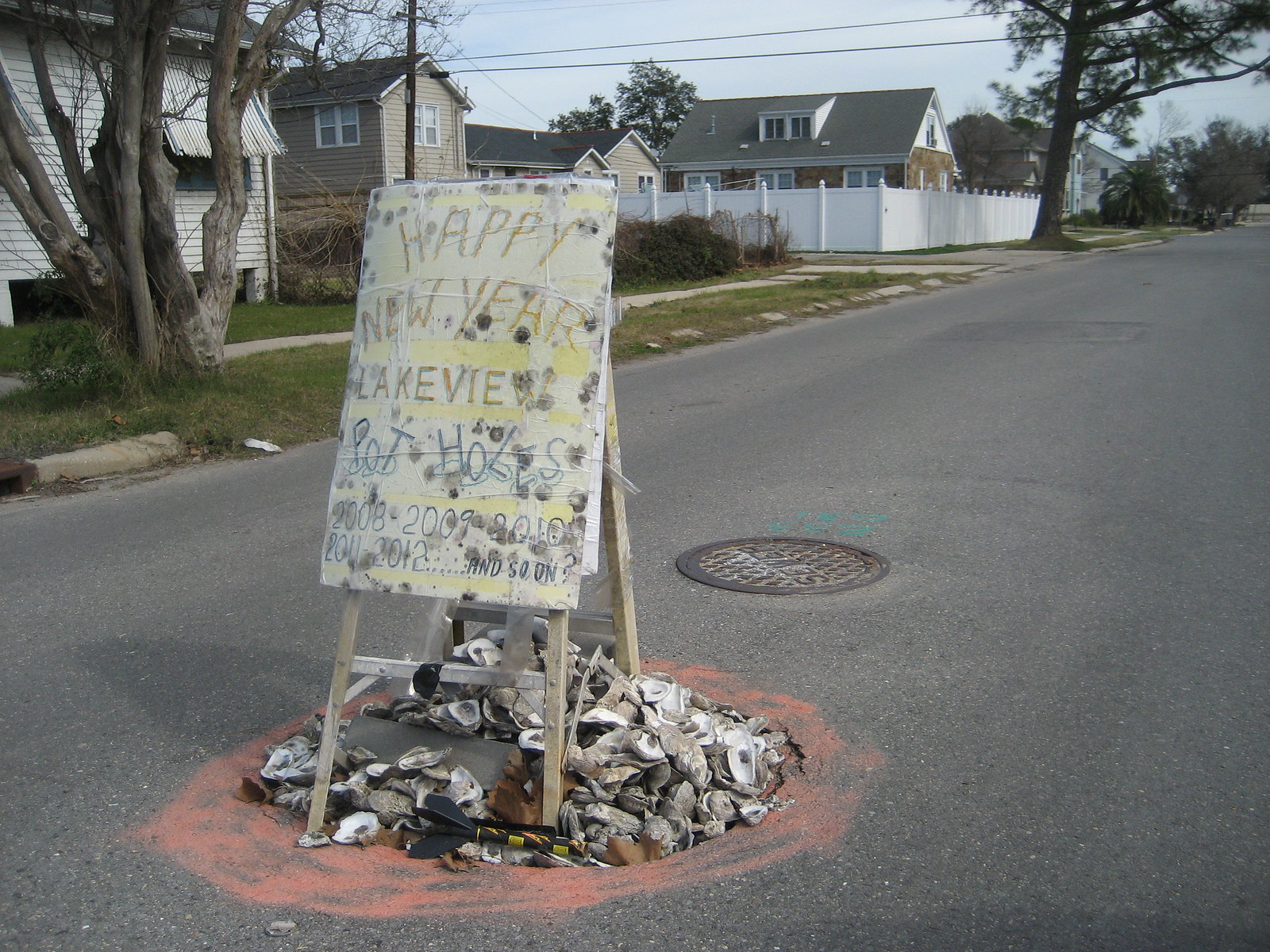
A sign in Beldar reads, “Welcome to Pothole City.” (Photo by: Infrogmation of New Orleans)
New Orleans’s collapsing roads and potholes are a danger, causing damage to cars and threatening the lives of drivers. Hitting a pothole can cause one’s tires to become bulged, scratched, or even punctured. In some cases, they can also dent one’s rims or cause fluid leaks if a fluid line or the axle is hit. Hitting a pothole may cause someone driving at a high speed to lose control, which could lead to a car accident.
Potholes come in a variety of shapes and sizes. They are often formed when water seeps under the pavement, freezes, and then thaws. The soil under the road gives way, creating a pothole. Potholes can also be caused by construction, heavy traffic conditions, compacting, and unsuitable locations.
According to LSU’s Center for Analytics and Research in Transportation, there were over 1,100 accidents involving serious injury and over 600 accidents involving a fatality on Louisiana roadways because of poor roadway conditions. That same center reports that “more than 65 percent of the roads in the city were given grades of D or worse . . . meaning they are in ‘poor’ shape at best. And of those roads, two-thirds were graded as F, meaning they are in ‘very poor’ or failing condition.”
Each year, the average New Orleans driver spends $657 on vehicle operating costs, like car repairs, because of the city’s poor roadway conditions. New Orleans resident Amy Rougelot remarks on potholes, saying “they’re mostly unpredictable, like you’ll drive down one street one day and the next day there will be a pothole or it will be flooded.” In the past two months, Amy has had to get two tires repaired.
New Orleans’s high temperatures can cause the pavement to soften and expand, which can also lead to potholes. Rising sea levels can also affect roads, making them less durable. Exposure to flooding can cause damage, necessitating more frequent maintenance, repairs, and rebuilding. The EPA reports that road infrastructure in coastal areas is “particularly sensitive to more frequent and permanent flooding from sea level rise and storm surges.”

A big pothole in the road. (Photo by: Jeff Bowen)
The city of New Orleans is “significantly slower” than other cities to resolve pothole complaints, sometimes taking over 6 months to respond to reports. From January 2019 to May 2021, the city’s Department of Public Works (DPW) took 204 days to resolve pothole requests, leaving unresolved requests pending indefinitely. Some service requests were even left unresolved for over 2.5 years. The Office of the Inspector General (OIG) found that the average time for pending requests was 348 days. In the meantime, New Orleans suggests that citizens continue to wait patiently, support Domino’s “Paving for Pizza” initiative, or fill the hole themselves. It is estimated to cost around $3.6 billion to repair roads to “fair” condition.

A pothole is filled with asphalt. (Photo by: LiteroX)
I believe a roadmap for solving New Orleans’s pothole issue can be found in Memphis. Memphis plans to fix potholes by doubling the number of crews who respond to pothole complaints. Public Works Director Robert Knecht said he plans to shift employees to street and pothole repair duties as soon as possible and incentivize working overtime hours to address the numerous potholes around Memphis.
Two of the most difficult problems New Orleans faces in implementing a similar pothole solution as Memphis are climate and funding. Scott Ferrell, of the Shreveport Times, writes, “Some of our climate conditions [cause potholes], especially in the south part of the state where you have problems with a lot of rain and soft soil that requires a bit more maintenance attention than places where you don’t have those types of conditions.” New Orleans’s location below sea level and its frequent natural disasters have also affected road repair and renovation.
The second issue New Orleans faces with pothole repair is funding. While not permanent long-term funding, Louisiana’s legislature approved a bill for “$690 million and 10 key infrastructure projects around the state,” including “$100 million for Shreveport’s I-49 inner city connector.” However, it is Baton Rouge and New Orleans that face the worst road conditions. The legislature’s willingness to allocate funds for road conditions in other parts of the state is promising, but their focus needs to be directed to these cities. Ferrell goes on to write that “roads would have to become legislators’ priority for a special session to be called. And funds for roads could come from increasing the decades-old gas tax, which hasn’t been politically popular in recent years.”

Pothole in the road. (Photo by: Infrogmation of New Orleans)
To implement a plan for potholes, it is most likely inevitable that New Orleans raises taxes. However, residents are not keen to agree, especially after the COVID-19 economic slowdown. Proper funding is necessary for New Orleans to afford road repairs. The Louisiana Capital Regional Planning Commission has been developing a process to identify areas where roadway conditions need improvements, which may lower costs associated with scouting locations for repairs.
Potholes are a part of daily life in New Orleans, but they do not need to be. Despite climate and funding concerns, New Orleans is a particularly tenacious, resilient city, and in my opinion, is more than equipped to tackle their pothole problem.
This piece was edited by Lily Plowden as part of Professor Kelley Crawford’s Digital Civic Engagement course at Tulane University.
 NOLAbeings
Multimedia artist Claire Bangser created NOLAbeings as a portrait-based story project that marries...
NOLAbeings
Multimedia artist Claire Bangser created NOLAbeings as a portrait-based story project that marries...
 Data corner: Adobe Suite (create a PDF, social media graphic, presentation, edit a photo and video
Data corner is where you go to work with analytics and top tech skills. It takes on everything from PERL and SQL to Canva and Sprout Social.
Data corner: Adobe Suite (create a PDF, social media graphic, presentation, edit a photo and video
Data corner is where you go to work with analytics and top tech skills. It takes on everything from PERL and SQL to Canva and Sprout Social.

Thank you for bringing this important issue to light. The statistics you shared about the number of accidents and fatalities due to poor road conditions in Louisiana are shocking and deeply concerning. It’s heartbreaking to hear about residents like Amy having to deal with constant car a small world cup and the dangers posed by unpredictable potholes.